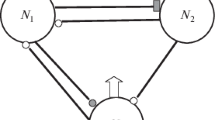Abstract
An asynchronous multi-agent multisorted system (AMMS) is a network of threshold elements (agents) operating in continuous time. The agents are either active or passive. When active, an agent generates a signal of certain type (color). The signal is perceived by all agents with inputs of the same color. The agent has a potential that changes under the exciting or inhibitory effect of signals; it is active only if its potential exceeds the threshold. Changes in the agent activity are events that break the timeline into clock periods—time intervals within which the state of the system does not change. The sequence of states of a system is called its behavior. The dependence of the autonomous network behavior on the network parameter values is studied.

Similar content being viewed by others
REFERENCES
Kuznetsov, O.P., Bazenkov, N.I., Boldyshev, B.A., et al., Asynchronous discrete model of chemical interactions in simple neuronal systems, Iskusstv. Intellekt Prinyatie Reshenii, 2018, no. 2, pp. 3–20.
Rao, A.S. and Georgeff, M.P., BDI-agents: from theory to practice, in Proc. First Int. Conf. Multiagent Syst. (ICMAS’95), Lesser, V., Ed., AAAI Press/The MIT Press, 1995, pp. 312–319.
Gorodetskii, V.I., Bukhvalov, O.L., Skobelev, P.O., and Maiorov, I.V., State-of-the-art and prospects of industrial applications of multiagent systems, Upr. Bol’shimi Sist., 2017, no. 66, pp. 93–157.
Muller, D.E. and Bartky, W.S., A theory of asynchronous circuits, Int. Symp. Switching Theory (Harvard Univ., 1959), pp. 204–243.
Varshavskii, V.I., Kishinevskii, M.A, Marakhovskii, V.B., et al., Avtomatnoe upravlenie asinkhronnymi protsessami v EVM i diskretnykh sistemakh (Automated Control of Asynchronous Processes in Computers and Discrete Systems), Moscow: Nauka, 1986.
Brzozowski, J.A., Topics in asynchronous circuit theory, Recent Adv. Formal Lang. Appl., 2006, vol. 25, pp. 11–42.
Kuznetsov, O.P., Asynchronous threshold networks with multisorted signals, Dokl. Ross. Akad. Nauk, 2019, vol. 487, no. 1, pp. 10–13.
Minsky, M., Computation: Finite and Infinite Machines, Englewood Cliffs, NJ: Prentice Hall, 1967.
Zhilyakova, L.Yu. and Gubanov, D.A., Double-threshold model of the activity spreading in a social network. The case of two types of opposite activities, Proc. 11th IEEE Int. Conf. Appl. Inform. Commun. Technol. AICT2017 (2017), vol. 2, pp. 267–270.
Zhilyakova, L.Yu., Modeling the structure of MIMO-agents and their interactions, in Artificial Intelligence. RCAI 2019. Communications in Computer and Information Science. Vol. 1093 , Kuznetsov, S. and Panov, A., Eds., Cham: Springer, 2019, pp. 3–16.
Funding
This work was supported in part by the Russian Foundation for Basic Research, projects nos. 17-29-07029 and 20-07-00190.
Author information
Authors and Affiliations
Corresponding author
Additional information
Translated by V. Potapchouck
Rights and permissions
About this article
Cite this article
Kuznetsov, O.P. Asynchronous Multi-Agent Multisorted Systems. Autom Remote Control 82, 294–307 (2021). https://doi.org/10.1134/S0005117921020089
Received:
Revised:
Accepted:
Published:
Issue Date:
DOI: https://doi.org/10.1134/S0005117921020089




